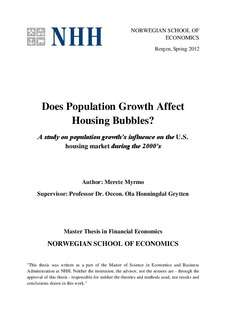Does population growth affect housing bubbles? : a study on population growth’s influence on the U.S. housing market during the 2000’s
Master thesis
Permanent lenke
http://hdl.handle.net/11250/169577Utgivelsesdato
2012Metadata
Vis full innførselSamlinger
- Master Thesis [4372]
Sammendrag
The purpose of this dissertation is to investigate the relationship between population growth and house prices. It analyses whether housing bubbles existed in American cities during the recent financial crisis by comparing the housing market development among cities with similar population growth trends. I use two empirical methods in order to identify housing bubbles. The price-to-rent and the price-to-income ratios determine whether house prices reflect fundamental market values throughout the period. Moreover, the qualitative analysis examines how monetary conditions and changes in housing regulations affected the American housing market during the 2000’s.
The dissertation concludes that positive population growth leads to increased demand, which initiate higher house prices and enhances the bubble formation risk. The analysis argues that bubbles existed in the cities with a sharp population growth rate prior to the crisis. However, the deviation between house prices and fundamental values were higher, before, during and after the financial crisis in cities with large stable population sizes. Hence, a sharp increase in population, which equals a steep rise in demand, is necessary to cause house prices to extensively exceed fundamental values and create housing bubbles. Furthermore, the findings indicate that both expansionary monetary policy and favorable housing market regulations facilitated the housing market’s boom and bust.
